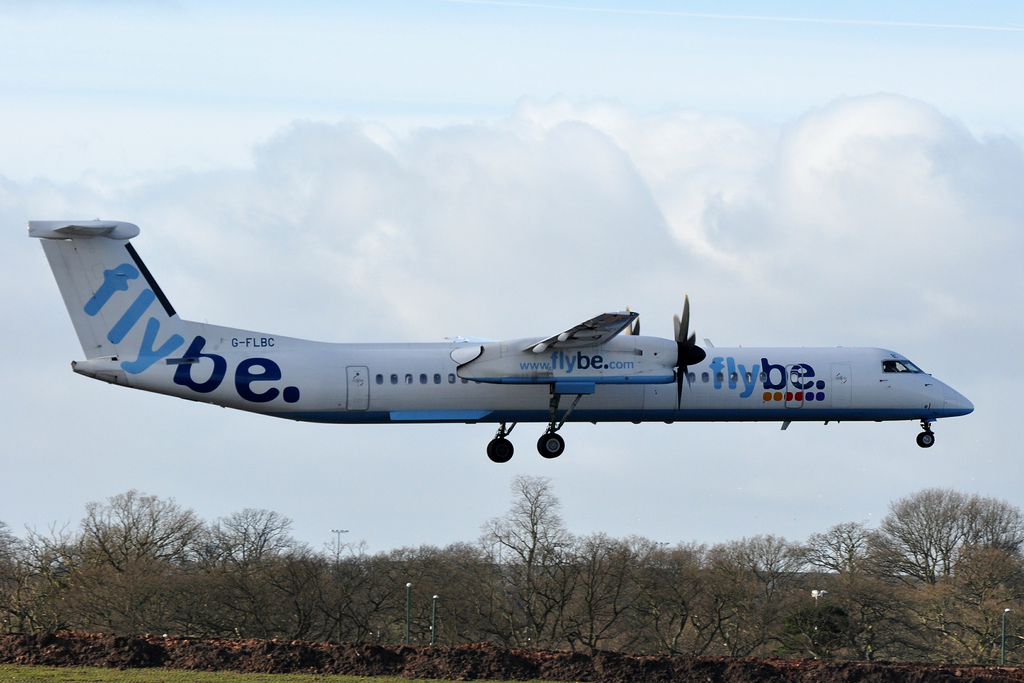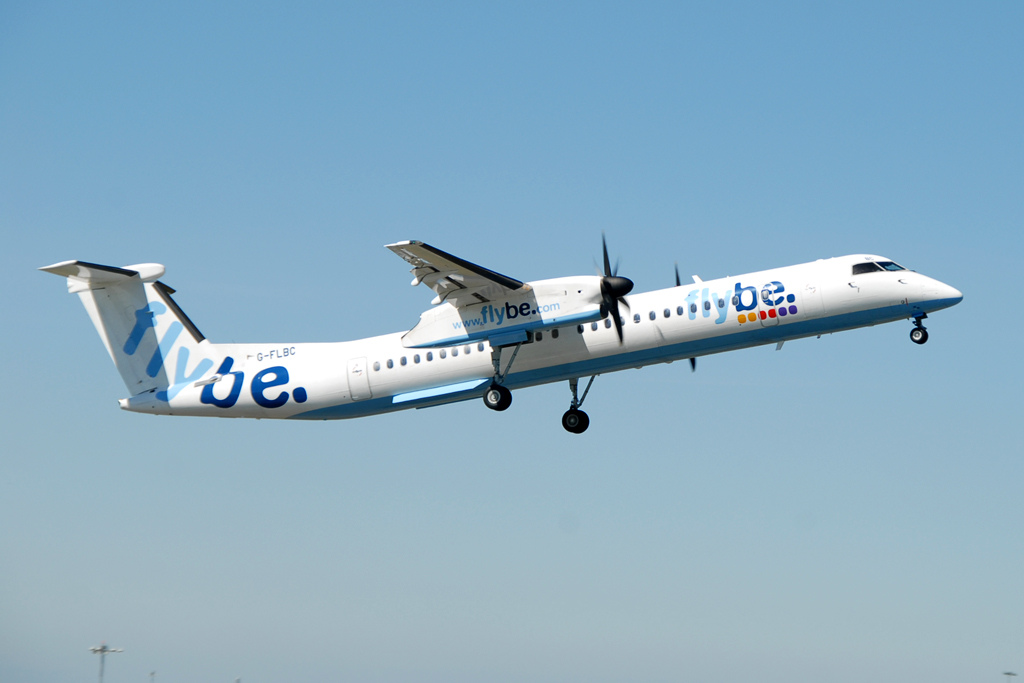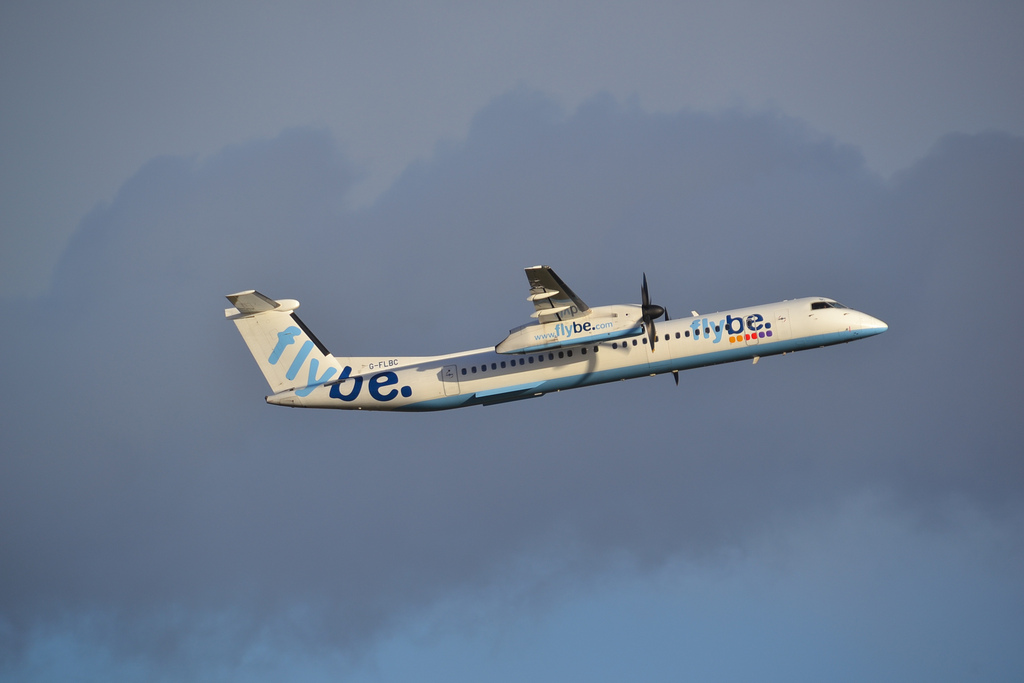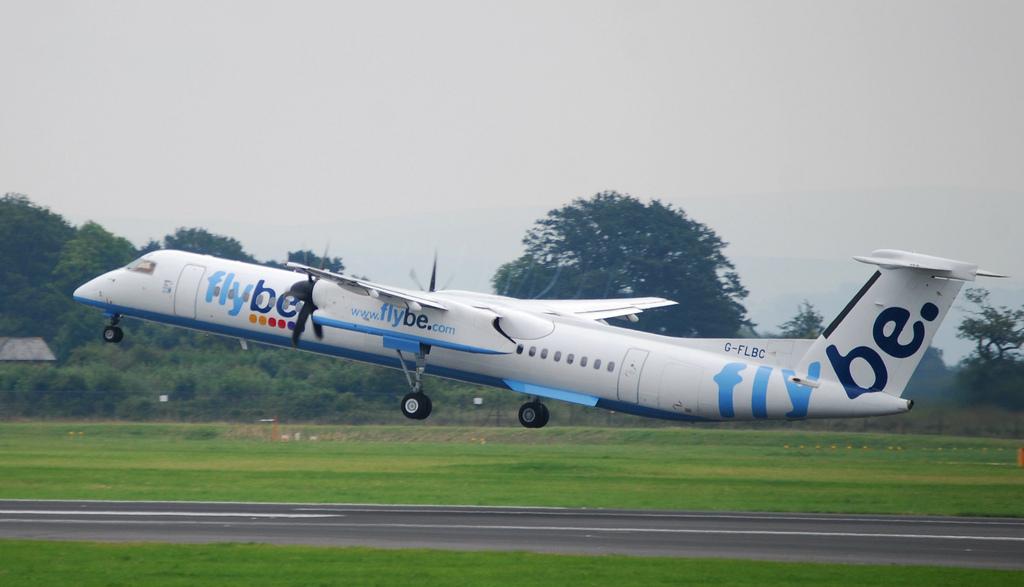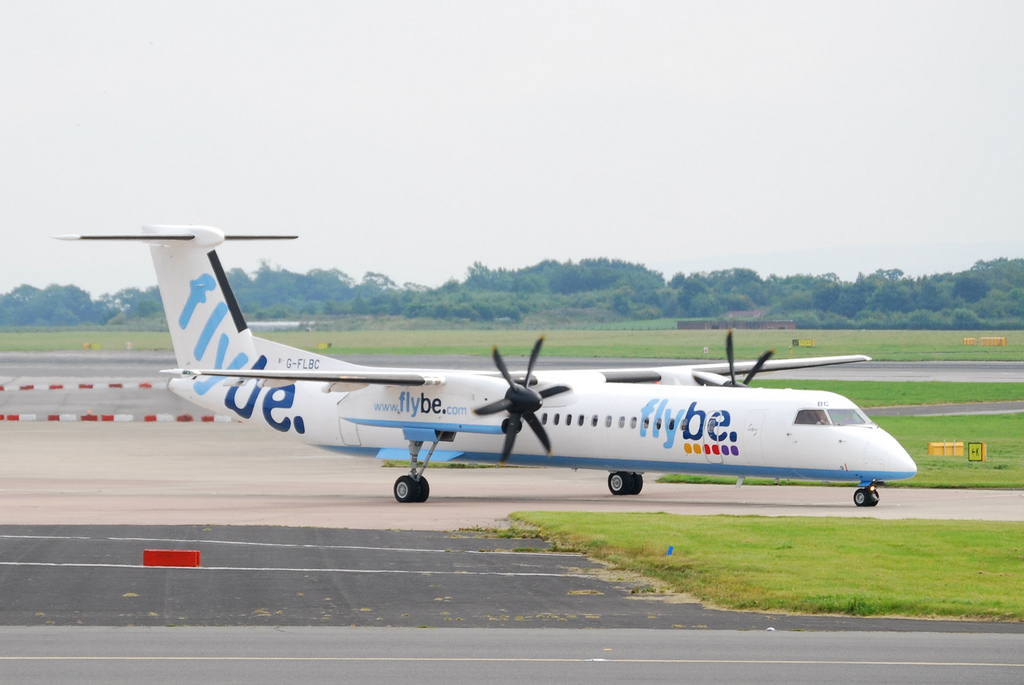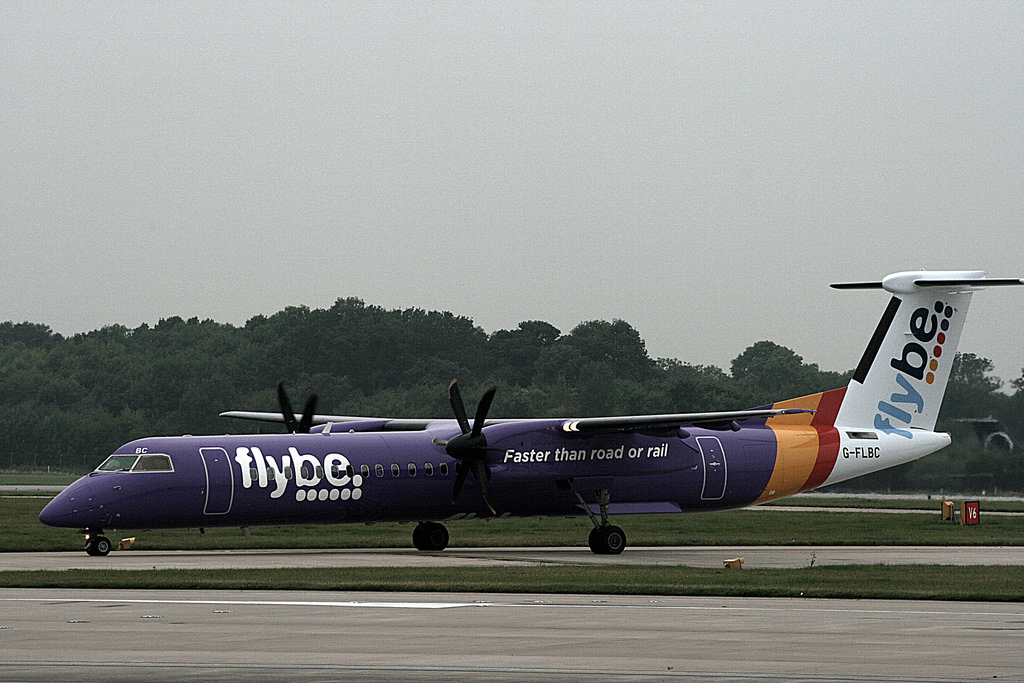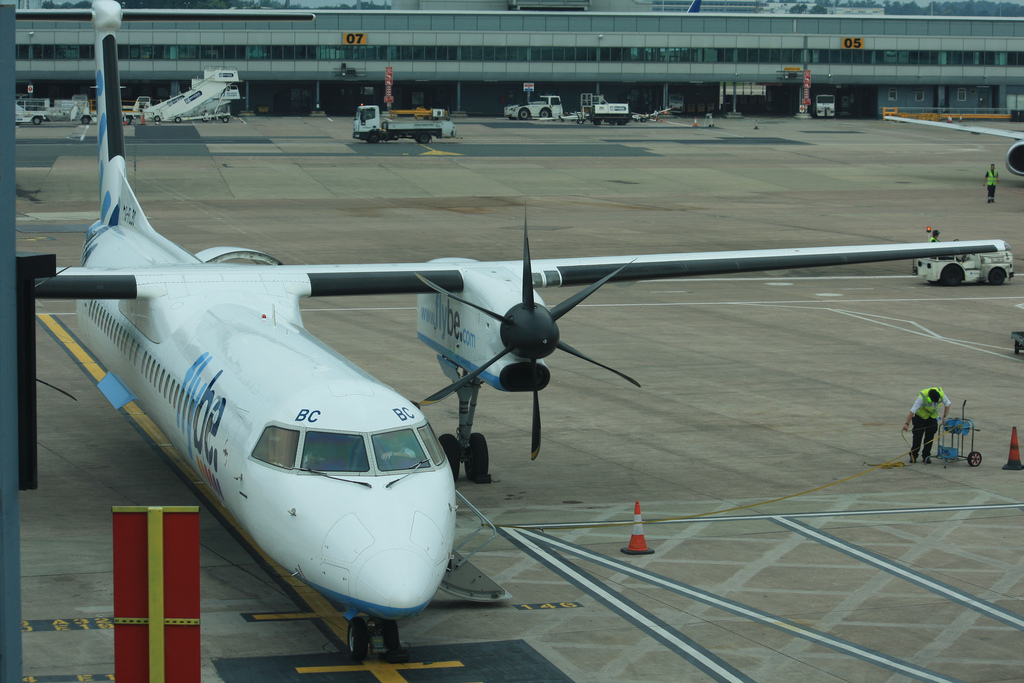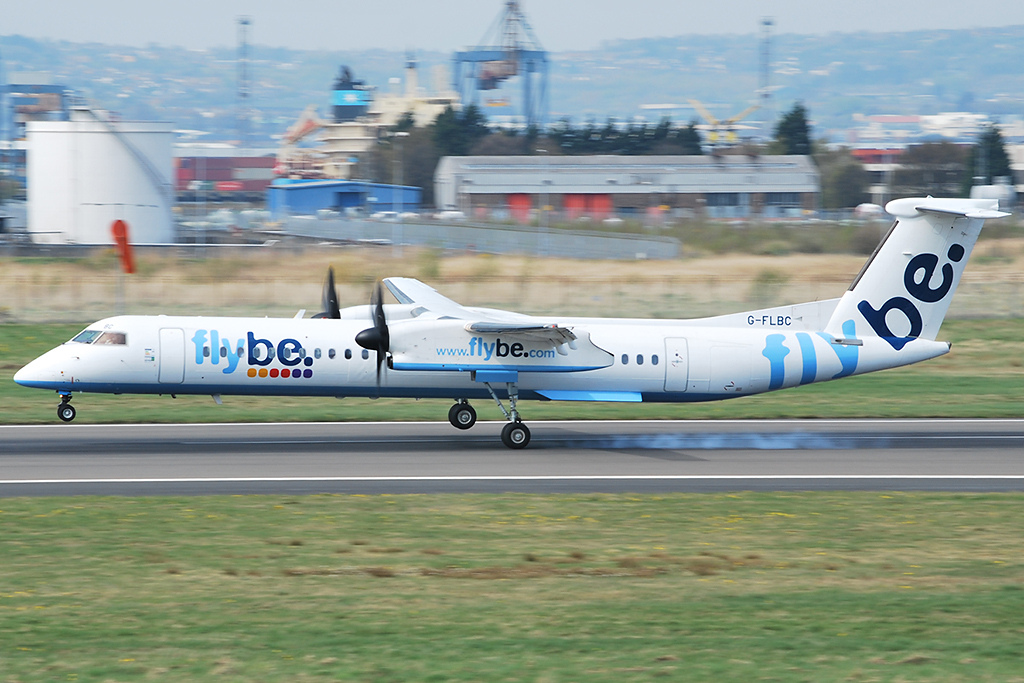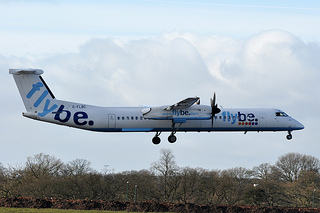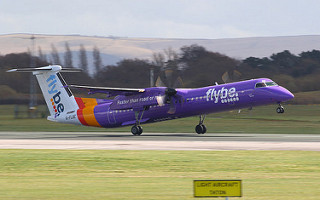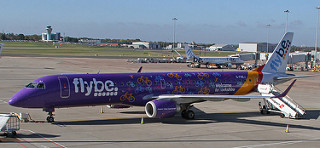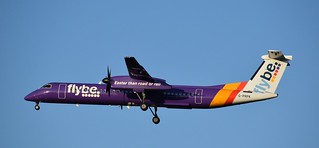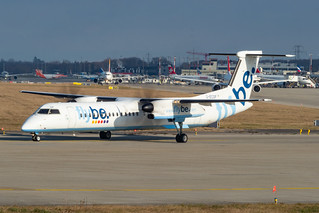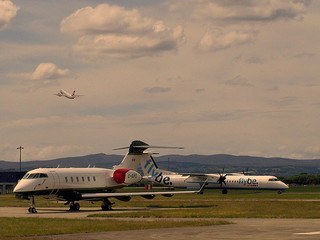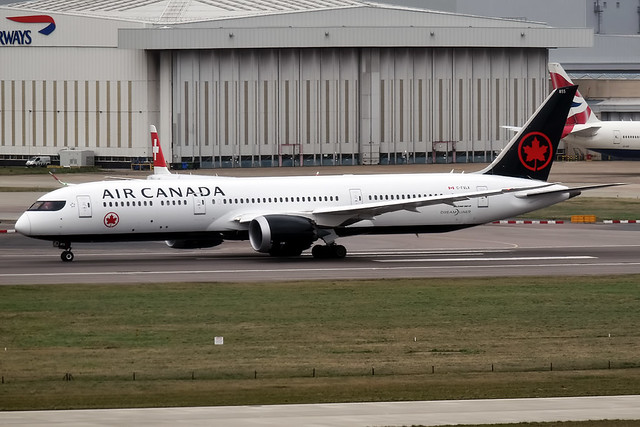Flybe DH8D near Belfast on Dec 16th 2014, engine fire
Last Update: June 9, 2016 / 15:56:14 GMT/Zulu time
Incident Facts
Date of incident
Dec 16, 2014
Classification
Incident
Cause
Engine fire
Airline
Flybe
Flight number
BE-130
Departure
Glasgow, United Kingdom
Destination
Belfast City, United Kingdom
Aircraft Registration
G-FLBC
Aircraft Type
De Havilland Dash 8 (400)
ICAO Type Designator
DH8D
The airline reported a small engine fire that was extinguished before landing.
Passengers reported there was shudder, a loud bang and streaks of flames from the exhaust of the left hand engine.
The AAIB rated the occurrence a serious incident and dispatched investigators on site.
On Jun 9th 2016 the AAIB released their bulletin concluding the causes of the serious incident were:
While the aircraft was in the climb to its cruising altitude, fatigue cracking of the left engine’s No 4 bearing key washer appears to have allowed a steel fragment to pass into the No 3/4 bearing cavity scavenge pump. This resulted in bearing damage, permitting disengagement of the drive to some of the scavenge pumps in the engine’s oil pump assembly, while the pressure supply and four other scavenge pumps continued to function. The ultimate absence of oil in the engine’s oil tank led to the total loss of lubrication and the rapid deterioration of dry bearings in the engine. This, in turn, caused engine shaft displacement and frictional rubs, creating internal titanium fires at a number of locations. The combustor case was penetrated, internal components were ejected and an external fire then developed.
The flight crew followed the QRH procedures for a loss of oil pressure and fire in the left engine and carried out a diversion to the nearest suitable airport. The fire extinguished after a few minutes but appeared to return shortly before the aircraft landed. The airport RFFS attended the aircraft when it stopped on the runway and observed signs of fire within the left engine nacelle. These were rapidly extinguished, while the passengers and crew evacuated from the aircraft.
In December 2015, the engine manufacturer issued an Alert Service Bulletin, SB A35325, requiring specialist internal inspection of engines to be carried out, in a time span dictated by the service life of the No 4 bearing key washer. In addition, the engine manual has been revised to instruct the replacement of the key washer upon access, and SB 35326 was issued in December 2015 to instruct replacement of the key washer at engine shop visits, regardless of the reason for engine removal. The engine manufacturer also introduced a new improved key washer in February 2016, as indicated in SB 35327.
The AAIB reported that while being pushed back and before the tug disconnected from the aircraft the operator of the tug advised it appeared the nose gear oleo had lost pressure, the aircraft returned to the stand. Following repair the aircraft departed about 45 minutes later.
The aircraft was climbing through FL151 towards FL160 when the crew received a "#1 ENG OIL PRESS" warning. The crew observed the oil pressure gauge fall to zero and change to "---", which according to manuals could indicate the signal from the oil pressure transmitter was lost. The crew therefore rechecked the engine instruments in an attempt to verify whether there had indeed been a loss of oil pressure.
The aircraft levelled off at FL160, then the crew worked the checklist for loss of engine oil pressure. When they retarded the left hand power lever, there was a judder throughout the airframe and the fire audio chime sounded briefly. The crew shut the engine down but did not discharge the fire agent as the fire indication was not active anymore. The crew declared PAN with ATC and advised of their intention to return to Glasgow. While turning back the fire indication and chime for the left hand engine activated again, the crew discharged the fire bottle and declared Mayday not advising they intended to divert to Belfast Aldergrove, the closest suitable airfield. As the fire indication continued the crew discharged the second bottle, the fire indication however continued to only deactivate after a number of minutes.
A first officer travelling as passenger was seated near the left hand engine with a good view of the engine. He provided the flight crew with commentary about what could be seen from the engine via the cabin purser. When the judder occurred, three subsequent "whoosh" noises could be heard from the engine, a large blue flame came out of the engine exhaust and sparks were visible from behind the left hand engine cowling just aft of the propeller. Several minutes after the event, coinciding with the second deactivation of the fire warning in the cockpit, it appeared the fire visible behind the engine cowling had gone out.
ATC offered the crew to remain on their current frequency in order to reduce workload, which was accepted by the crew, as a consequence emergency services were not able to listen to the transmissions from the aircraft, ATC relayed information from the aircraft.
Shortly before touchdown the first officer as passenger observed indications of fire behind the left hand engine cowling again, the flight crew advised air traffic control that there were reported of engine fire from the cabin again though no indications on the flight deck. Emergency services therefore prepared for entering a burning aircraft and donned their oxygen masks. The aircraft landed and stopped on the runway after having turned into the wind. Emergency services observed a small fire visible through a vent grill on the left hand side of the left hand engine and advised ATC that the left side was on fire. This was relayed to the commander, who initiated an emergency evacuation of the aircraft. Fire crews were able to quickly extinguish the engine fire.
Cabin crew opened the forward left door and seeing no fire instructed the passengers to evacuate through that door, both left and right rear doors were opened, too, passengers were surprised at the height they needed to jump down with no slides fitted to those doors, a number of passengers received minor injuries including bruises and cuts, one passenger was taken to a hospital for chest pain and anxiety.
After collecting the passengers the head count revealed one passenger was missing. It turned out that the positioning first officer had remained with the crew.
In a post occurrence examination AAIB investigators found paint blisters indicative of heat at both outboard and inboard aft engine access doors, extensive heat damage was found after opening the doors. On opening the forward nacelle doors the engine appeared relatively free from smoke and heat. The oil level was at the very bottom of the range visible in the sight glass.
The engine outer case showed several holes in the insulation blanket around the lower part of engine combustor and a number of components from the combustor were found on the decking below the engine case. The power turbine could be seen turning when the propeller was turned, however, attempts to turn the low pressure compressor were unsuccessful suggesting the shaft was seized.
The magnetic chip detector at the engine's lubrication system was found heavily contaminated with metallic debris, the other two chip detectors at the generator and gear drive were found clean.
Both fire bottles were found completely discharged.
The left hand engine as well as left hand engine nacelle and systems forward of the firewall were replaced.
The AAIB summarized the engine manufacturer's findings:
Following arrival at the manufacturer’s plant, the oil from the reduction gearbox was drained and it was noted that substantially more oil than normal was present in that unit.
Accelerated wear type failure was noted in a number of bearings, particularly the No 4 bearing. Unusual dryness was noted in undamaged bearings Nos 6.5 and 7, at the rear of the engine. Study of the internal engine features indicated that failure of the No 4 bearing would have permitted forward displacement of the HP spool, leading to extensive contact damage between the forward face of the HP compressor impellor and its casing. Such damage was clearly evident when the impellor and casing were examined.
A major proportion of the titanium alloy structure of the engine had been destroyed, apparently by fire. This damage was widespread, but particularly concentrated in the structural volume between the gas flow path and the centreline, behind the impellor and in the region of the No 5 bearing. The mounting web of the No 5 bearing had been destroyed by fire.
Gross tip damage to the HP turbine blades was evident. This was consistent with rotating blade tip contact with the casing, due to loss of location of the outer race of the No 5 bearing following destruction of its mounting web. It was also consistent with over-fuelling of the engine, as a result of non-standard flow conditions arising from turbomachinery damage and reduction of rpm below the demanded value, owing to impellor rubbing and elevated frictional torque in the HP shaft.
Examination of the combustor
Damage to the combustor casing took the form of a number of holes lying radially in the plane of the exit from the HP impellor. These punctures had occurred apparently as a result of hot debris passing through the casing, after first impacting and penetrating the inner faces of some of the ‘fish-tails’. The diffuser exit ducts, leading from the impellor exits, appeared to have directed this high energy material - a number of ‘fish-tails’ had separated from the ducts and themselves passed through the largest of the holes in the combustor.
Detailed examination of the lubrication system and bearings
As previously noted, the oil tank was observed to be effectively empty when the aircraft was first examined. No oil was present in the turbo-machinery section of the engine but samples were successfully taken from the RGB and the accessory gearbox.
Examination revealed that the No 4 bearing had deteriorated as a consequence of a grinding effect on one of the races, permitting forward movement and contact of the titanium alloy impellor with its casing. The bearing condition was consistent with the effect of continuing operation, without any initial damage but an absence of lubricant. Nos 6.5 and 7 bearings were noted to be undamaged but unusually dry, as would be expected when oil starvation occurred for a short period of operation.
Preliminary examination of the oil pressure/scavenge pump assembly indicated that the upper bearing of the ‘driven’ element of the pump was damaged and internally deformed, allowing both axial and radial movement of the gear, thus permitting it to come out of mesh with the corresponding ‘driving’ gear. The complete pump assembly was seized ie none of the elements could be rotated.
The disengaged gears normally transfer the drive from the input shaft to a stack consisting of scavenge pumps for the Nos 3/4 and 6/6.5 cavities, AC (alternating current) generator drive and the RGB. The shear neck on the input drive to the combined pressure/scavenge pump assembly was intact and metallurgical examination indicated that its strength would have been in the normal range.
The oil pressure/scavenge pump unit was subjected to X-ray computed tomography (CT) scanning, before being forwarded to its manufacturer for examination. That examination revealed that a lateral breakout failure of the upper bearing of the driven stack (see Figure 6) had allowed its axis to be displaced, permitting disengagement of the gears.
This had resulted in loss of drive to all the scavenge pumps, except for No 2/2.5, 5 and 7, and that for the accessory gearbox. Dismantling revealed that numerous vanes were jammed in their slots in the rotors and evidence of significant overheating was present.
Laboratory examination of various items of debris from the pump initially indicated that the reason for vane seizure was the presence of re-solidified titanium in the slots and in the spaces below some of the vanes: titanium alloy is not used in the manufacture of the pump unit.
The AAIB analysed:
It was concluded that fuel was liberated into a volume within the nacelle, from the holed external fuel pipe, and was exposed to the hot/burning centre of the engine carcase via the punctures in the combustor case. Much of the external heat damage to the engine is difficult to account for, other than as a result of an external fuel-fed fire. However, it is likely, from the EMU and FDR data and a study of the engine damage, that an internal fire had begun approximately 1 minute after the loss of oil pressure. Initially, burning at such a location is unlikely to have significantly altered conditions external to the engine casing or to have caused the fire warning to operate. Therefore, it is likely that an undetected internal fire persisted for a period before the combustor was penetrated and the fuel pipe became holed.
Following the fire warning, the fire suppression system was operated, both bottles being fired over a period. Although a flight crew member being carried in the cabin subsequently reported fire still being visible through gaps and louvres in the cowling, no further fire warning was reported.
Fire crew on the ground saw signs of fire beneath the cowling immediately after the aircraft landed. The nature of the titanium structure of the engine is such that the transfer of heat from within the core of the engine to visible areas on the outside casing of the unit would have been gradual. It is possible that, as a result of delayed conduction from the core of the engine, parts of the exterior casing glowed red and became visible in the darkness after the external fuel-fed fire ceased, or that a small amount of residual fuel from the engine fuel system continued to drain from the punctured fuel pipe, being re-ignited by the hot exterior of the engine casing. In addition, the elevated temperature of the exterior of the engine, once stationary on the ground, probably led to charring and smoke emission from insulation of cables and pipes on the exterior of the engine.
Incident Facts
Date of incident
Dec 16, 2014
Classification
Incident
Cause
Engine fire
Airline
Flybe
Flight number
BE-130
Departure
Glasgow, United Kingdom
Destination
Belfast City, United Kingdom
Aircraft Registration
G-FLBC
Aircraft Type
De Havilland Dash 8 (400)
ICAO Type Designator
DH8D
This article is published under license from Avherald.com. © of text by Avherald.com.
Article source
You can read 1 more free article without a subscription.
Subscribe now and continue reading without any limits!
Read unlimited articles and receive our daily update briefing. Gain better insights into what is happening in commercial aviation safety.
Send tip
Support AeroInside by sending a small tip amount.
Related articles
Flybe DH8D near East Midlands on Jan 28th 2019, loss of cabin pressure
A Flybe de Havilland Dash 8-400, registration G-FLBC performing flight BE-262 from East Midlands,EN to Edinburgh,SC (UK) with 59 passengers and 4…
Flybe DH8D near Southampton on Jul 13th 2017, possibly cracking windshield
A Flybe de Havilland Dash 8-400, registration G-FLBC performing flight BE-981 from Belfast City,NI to Southampton,EN (UK) with 58 people on board,…
Flybe DH8D near Norwich on Dec 21st 2016, door problem
A Flybe de Havilland Dash 8-400, registration G-FLBC performing flight BE-7049 from Birmingham,EN (UK) to Dusseldorf (Germany), was enroute at FL250…
Flybe DH8D at Newquay on Nov 14th 2019, aileron cable broke
A Flybe de Havilland Dash 8-400, registration G-FLBE performing flight BE-2187 from Newquay,EN to London Heathrow,EN (UK) with 59 passengers and 4…
Flybe E195 at Exeter on Feb 28th 2019, rejected takeoff due to haze on board as result of maintenannce prompts evacuation
A Flybe Embraer ERJ-195, registration G-FBEJ performing flight BE-4321 from Exeter,EN (UK) to Alicante,SP (Spain) with 100 passengers and 5 crew, had…
Flybe DH8D near BIrmingham on Jul 22nd 2019, cabin pressure problems
A Flybe de Havilland Dash 8-400, registration G-PRPK performing flight BE-1331 from Edinburgh,SC to London City,EN (UK) with 56 passenges and 4 crew,…
Flybe DH8D near Manchester on Nov 22nd 2019, engine shut down in flight
A Flybe de Havilland Dash 8-400, registration G-ECOF performing flight BE-774 from Southampton,EN to Edinburgh,SC (UK) with 69 people on board, was…
Flybe DH8D near Exeter on Nov 15th 2018, altitude disagree
A Flybe de Havilland Dash 8-400, registration G-JECR performing flight BE-3501 from Exeter,EN (UK) to Paris Charles de Gaulle (France), was enroute…
Newest articles
EAT Leipzig A306 at Brussels on Nov 26th 2020, rejected takeoff above V1 due to difficulties becoming airborne
An EAT Leipzig Airbus A300-600 freighter on behalf of DHL, registration D-AEAI performing flight QY-841 from Brussels (Belgium) to Vitoria,SP…
Canada B789 at Auckland on Jan 13th 2026, unusual odour
An Air Canada Boeing 787-9, registration C-FVLX performing flight AC-40 from Auckland (New Zealand) to Vancouver,BC (Canada) with 269 passengers and…
Subscribe today
Are you researching aviation incidents? Get access to AeroInside Insights, unlimited read access and receive the daily newsletter.
Pick your plan and subscribePartner

ELITE Simulation Solutions is a leading global provider of Flight Simulation Training Devices, IFR training software as well as flight controls and related services. Find out more.
SafetyScan Pro provides streamlined access to thousands of aviation accident reports. Tailored for your safety management efforts. Book your demo today
AeroInside Blog
Popular aircraft
Airbus A320Boeing 737-800
Boeing 737-800 MAX
Popular airlines
American AirlinesUnited
Delta
Air Canada
Lufthansa
British Airways
